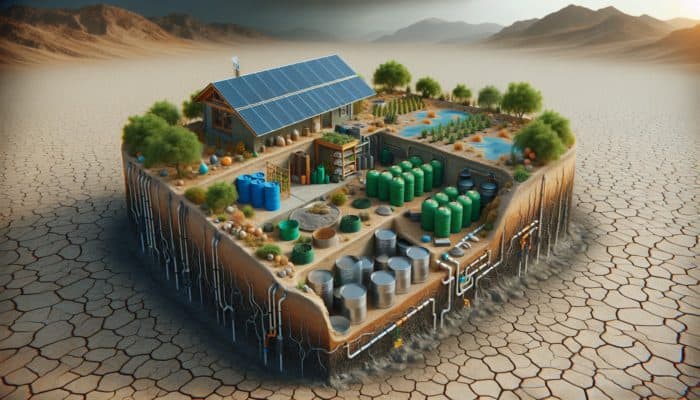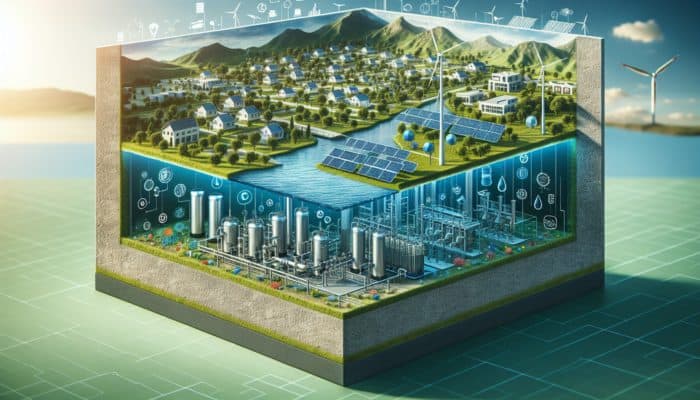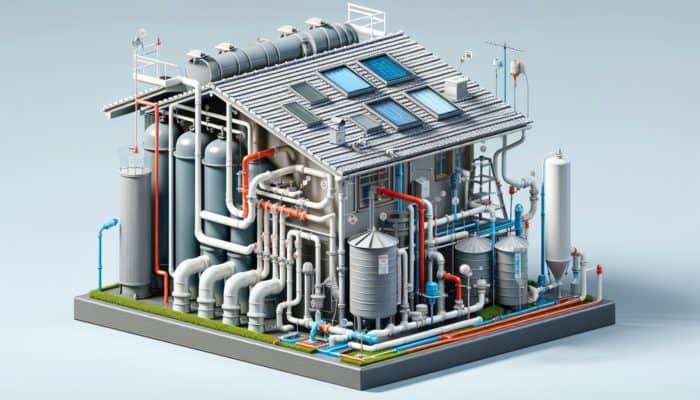Ultimate Resource for Effective Water Collection Systems and Sustainable Water Management
What Are the Key Features That Define Water Collection Systems?

Water collection systems comprise a range of advanced technologies and methodologies specifically engineered to capture, store, and utilise water sourced from various origins, primarily focusing on rainwater. These systems are indispensable for the sustainable management of water resources, particularly in areas suffering from water scarcity. By employing these innovative systems, communities can effectively alleviate the negative impacts of drought and reduce dependency on municipal water supplies, ultimately fostering more efficient water resource utilisation. Through the collection of natural precipitation and runoff, these systems supply clean water for numerous applications, including irrigation, landscaping, and, following adequate treatment, even for potable use. Their adaptability ensures they are vital tools in promoting responsible water consumption practices.
The efficiency of water collection systems can vary considerably across different geographical locations, heavily influenced by local climate conditions and the unique demands of communities. For instance, regions with tropical climates that receive substantial rainfall can successfully implement rooftop systems, while arid areas might rely more on methods for gathering surface runoff. Each water collection system is meticulously crafted to cater to the specific environmental and social needs of the communities they support, thereby offering adaptable solutions to a broad spectrum of water-related challenges.
Diving into the Various Types of Water Collection Systems Available
A wide range of water collection systems exists, each meticulously designed to address the unique requirements arising from different geographical and climatic conditions. Each type is equipped with specific features that enhance its performance in particular environments. The three main categories of systems include:
- Rooftop Systems: These systems proficiently capture rainwater from rooftops, directing it through gutters into storage tanks for later use. They are especially common in urban settings, leveraging existing infrastructure to optimise water collection.
- Surface Collection Systems: These systems collect water from land surfaces, such as ponds or swales, where rainfall or runoff can accumulate. They are particularly beneficial in agricultural environments for irrigation purposes.
- Subsurface Systems: This category focuses on extracting groundwater through perforated pipes or trenches. These systems are effective in regions where groundwater is abundant and can be accessed safely without contamination concerns.
Each system performs a distinct function based on environmental conditions and intended uses, enabling communities around the globe to adopt practices that significantly enhance water sustainability and security.
What Are the Major Benefits of Implementing Water Collection Systems?
The adoption of water collection systems brings forth numerous advantages that extend far beyond mere water conservation. By efficiently capturing and utilising rainwater, communities can substantially lessen their reliance on municipal water supplies. This shift leads to significant reductions in water bills and eases the burden on overstretched water treatment facilities.
Moreover, these systems contribute positively to environmental sustainability. By minimising runoff and reducing the need for extensive stormwater management infrastructure, they help protect local ecosystems from degradation. In regions facing water scarcity, such as various parts of Africa and the Middle East, water collection systems are crucial for ensuring consistent access to this essential resource. Beyond the immediate benefits of conserving water, these systems foster a greater awareness of the importance of sustainable water practices, promoting a cultural shift towards responsible water management.
How Do Water Collection Systems Operate with High Efficiency?

Understanding the Essential Components That Make Up Water Collection Systems
The successful functioning of water collection systems hinges on several critical components that work in harmony to efficiently capture, store, and distribute water. The primary elements of these systems include:
- Catchment Surfaces: These designated areas, such as roofs or paved surfaces, are responsible for collecting water.
- Conveyance Systems: This encompasses gutters, pipes, and channels that transport water from the catchment area to storage facilities.
- Storage Tanks: Tanks or cisterns act as reservoirs for the collected water, protecting it from contamination and evaporation.
- Treatment Units: Depending on the intended application of the water, it may require filtration and treatment to ensure safety for consumption or irrigation.
Each component is carefully engineered to meet the specific requirements of the water collection system, ensuring optimal efficacy. The interaction among these elements is vital for achieving high efficiency and sustainability in water management practices.
What Are the Steps Involved in Setting Up a Water Collection System?
Establishing an effective water collection system involves several systematic steps that ensure its proper functioning. The process begins with a thorough site assessment aimed at determining the most suitable location for installation. This evaluation includes analysing the topography, rainfall patterns, and existing structures that can be integrated into the system.
Following the site assessment, the next phase is system design. This stage involves selecting appropriate materials and determining the layout for the catchment surfaces, conveyance systems, and storage facilities. Proper sizing is critical to accommodate peak rainfall events and ensure sufficient water storage capacity. Once the design receives approval, the installation phase begins, where components are constructed or assembled according to the predetermined plan.
Lastly, ongoing maintenance is essential to ensure the longevity and efficiency of the system. This includes regular inspections for leaks, clogs, and water quality, along with cleaning catchment surfaces and storage tanks. By following these steps, communities can establish effective and dependable water collection systems that sustainably meet their water needs.
What Maintenance Strategies Are Effective for Keeping Water Collection Systems Functioning Smoothly?

Maintenance is a crucial aspect of sustaining the operational effectiveness of water collection systems. Regular inspections and proactive interventions can help identify common issues such as leaks, contamination, and blockages before they escalate into serious problems. For example, roof gutters should be regularly cleaned to prevent debris accumulation that could hinder water flow.
Leaks within the piping system can lead to significant water loss and must be addressed promptly. Routine evaluations of storage tanks are equally important; sediment buildup can compromise water quality, necessitating thorough cleaning and upkeep. Furthermore, treatment units require diligent monitoring to ensure they are functioning effectively, as any malfunction could jeopardise the safety of the collected water.
Effective troubleshooting practices not only involve identifying potential issues but also implementing preventive measures. This may include installing filters to reduce contamination, using seals to prevent leaks, or integrating smart monitoring systems that alert operators to any irregularities in water flow or quality. By prioritising maintenance, communities can enhance the longevity and reliability of their water collection systems.
What Varieties of Water Collection Systems Are Available for Use?
As previously mentioned, a variety of water collection systems has been meticulously tailored to suit diverse environments and requirements. Each system is ingeniously designed to optimise water harvesting efficiently and effectively. Rooftop systems are particularly prevalent in urban areas, where roof space is available for collection. Conversely, surface collection systems are often utilised in rural settings, especially for agricultural purposes.
Subsurface systems, which tap into groundwater, are advantageous in regions with a high water table and minimal contamination risks. Other innovative solutions, such as rain gardens and permeable pavements, enhance water collection further by allowing rainwater to filter naturally into the ground while supporting local flora and fauna.
Ultimately, the selection of a system will depend on various factors, including local climate conditions, available technology, and community needs. By thoughtfully choosing the appropriate type, communities can optimise their water collection efforts, ensuring a sustainable and reliable water supply.
What Are the Advantages and Challenges Associated with Water Collection Systems?
The adoption of water collection systems offers significant benefits, particularly regarding water conservation and economic savings. Communities that successfully implement these systems can noticeably decrease their reliance on municipal water sources, leading to reduced water bills and less strain on local infrastructure.
Moreover, these systems cultivate a culture of sustainability, encouraging individuals to engage more consciously in their water usage. The environmental benefits are extensive; by capturing rainwater, these systems mitigate stormwater runoff, which can cause flooding and water pollution. However, challenges do exist, such as initial installation costs and ongoing maintenance needs. Communities must also address potential water quality concerns, ensuring that the collected water is safe for its intended applications. Despite these challenges, the long-term benefits of water collection systems outweigh the drawbacks, making them a valuable investment for sustainable water management.
Expert Recommendations for Optimising Water Collection Systems
What Are the Best Practices for Designing Efficient Water Collection Systems?
Effectively designing water collection systems is crucial for maximising their efficiency and longevity. Best practices emphasise the importance of understanding regional climatic conditions, as these factors directly influence rainfall patterns and collection potential. For instance, areas that experience heavy monsoon seasons may require larger catchment surfaces and storage capacities to accommodate peak rainfalls, while regions with unpredictable rainfall can benefit from more compact systems.
The selection of materials is equally critical; employing durable, corrosion-resistant materials can significantly enhance system longevity and reduce maintenance costs. Additionally, accurately sizing tanks and pipes ensures that systems can meet both average and peak water demands without overflow or shortages. An exemplary instance of effective system design can be observed in the implementation of rainwater harvesting across urban areas in Singapore. The city utilises a combination of rooftop systems and underground storage to efficiently collect rainwater within a densely populated environment.
In conclusion, adhering to these best practices during the design phase leads to the creation of resilient water collection systems that can adapt to changing environmental conditions and evolving community needs.
What Innovations Are Revolutionising Water Collection Technology?
The domain of water collection systems is witnessing remarkable advancements that enhance operational efficiency and sustainability. Cutting-edge filtration technologies have emerged, enabling the effective purification of harvested rainwater, making it safe for both drinking and agricultural applications. Smart monitoring systems equipped with sensors now provide real-time data on water levels, quality, and system performance, allowing for proactive maintenance measures to be implemented.
Moreover, the incorporation of eco-friendly materials in system construction is gaining traction. Rainwater harvesting systems are increasingly being integrated with renewable energy sources, such as solar panels, to power pumps and filtration units, thus reducing the carbon footprint associated with water collection. Innovations in modular design also facilitate scalability, enabling communities to expand their systems as their needs increase. These advancements not only enhance the functionality of water collection systems but also underscore a broader commitment to sustainable water management practices globally.
What Trends Are Shaping the Future of Water Collection Systems?
The latest trends in water collection systems indicate a shift towards more integrated and community-focused approaches. One notable trend is the heightened adoption of green infrastructure, such as bioswales and rain gardens, which assist in slowing down and capturing stormwater while simultaneously enhancing urban aesthetics.
Furthermore, there is a growing emphasis on community-based water management initiatives that empower local populations to take control of their water resources. These collaborative approaches foster engagement and encourage a deeper understanding of sustainable water practices. The integration of water collection systems with renewable energy solutions is also becoming increasingly prevalent, reflecting a holistic perspective on sustainable development.
As communities progressively recognise the importance of water conservation, these trends signify a collective commitment to enhancing water sustainability and resilience in the face of climate change and resource scarcity.
Assessing the Environmental Benefits of Water Collection Systems
How Do Water Collection Systems Promote Environmental Conservation?
Water collection systems are instrumental in fostering environmental conservation. By capturing rainwater and reducing reliance on conventional water sources, these systems alleviate the pressure on natural water resources, thereby aiding in the preservation of aquatic ecosystems. This is especially critical in areas where over-extraction of water has led to habitat degradation.
Additionally, by minimising stormwater runoff, water collection systems help prevent soil erosion and safeguard water quality in nearby rivers and lakes. This not only supports local biodiversity but also strengthens the resilience of ecosystems facing pressures from urban expansion and climate change. The advantages of these systems extend beyond immediate water conservation; they contribute to a healthier environment and a more sustainable future for all.
How Can Effective Water Collection Reduce Carbon Footprint?
The integration of water collection systems into comprehensive water management strategies can significantly lower a community’s carbon footprint. By diminishing reliance on municipal water treatment and distribution, these systems decrease the energy consumption typically associated with these processes. Water collection systems can play a crucial role in reducing greenhouse gas emissions, particularly in areas where energy for water treatment is derived from fossil fuels.
Furthermore, by promoting local water use, these systems can reduce the infrastructural demands for extensive water distribution networks, ultimately leading to lower energy costs related to pumping and treating water sourced from distant locations. In the context of global initiatives aimed at combating climate change, implementing efficient water collection systems represents a proactive approach to sustainable living and environmental stewardship.
What Role Do Water Collection Systems Play in Advancing Sustainable Practices?
Water collection systems are essential for achieving sustainability objectives across numerous sectors. They facilitate water conservation, reduce waste, and promote responsible water use within communities. By harnessing rainwater, these systems provide an alternative water source that alleviates pressure on dwindling freshwater supplies.
Moreover, their implementation can cultivate a culture of sustainability, encouraging individuals and organisations to prioritise eco-friendly practices in their daily operations. As communities increasingly recognise the significance of sustainable water management, the role of water collection systems is set to expand, highlighting their necessity in developing resilient and sustainable communities.
Exploring the Economic Benefits of Water Collection Systems
How Can Water Collection Systems Lead to Cost Savings?
Implementing water collection systems can yield substantial cost savings for both individuals and communities. By capturing and utilising rainwater, households can greatly reduce their water bills, especially in regions where water costs are elevated. The reduced reliance on municipal water sources alleviates the burden on local utilities, resulting in lower costs for all stakeholders.
In addition to savings on water bills, these systems can significantly diminish expenses related to water treatment and infrastructure maintenance. For instance, agricultural communities that adopt water collection practices can lower their irrigation costs while simultaneously enhancing crop yields. As the demand for sustainable water management solutions continues to rise, the economic advantages of water collection systems become increasingly apparent, making them an appealing option for both urban and rural environments.
What Economic Advantages Do Water Collection Systems Offer to Local Communities?
The economic benefits of water collection systems extend beyond individual savings, positively impacting entire communities. These systems can create job opportunities in installation, maintenance, and system design, thereby fostering local economic growth. Furthermore, communities that implement effective water collection systems often see an increase in property values, as homes equipped with such systems tend to attract prospective buyers.
Moreover, communities with robust water collection systems enjoy improved water security, which is vital for local industries and agriculture. The assurance of a reliable water supply can stimulate economic growth and investment, creating a stable environment conducive to business development. As communities prioritise sustainable water practices, the broader economic benefits become clear, contributing significantly to the overall well-being of local populations.
What Funding Opportunities Are Available for Water Collection Initiatives?
Investing in water collection systems can unveil numerous funding opportunities for communities and organisations. Many government agencies provide grants and incentives to promote water conservation and sustainable practices. Environmental organisations also offer financial support for projects focused on enhancing water management systems.
Private investors are increasingly recognising the value of sustainable water solutions, forming potential partnerships to fund innovative water collection technologies. By exploring these funding avenues, communities can strengthen their water collection infrastructure, leading to enhanced resilience and sustainability in water management. As investment in water collection systems continues to grow, so too do the opportunities for communities to develop sustainable solutions tailored to their specific needs.
Imagining the Future of Water Collection Systems
What Factors Will Influence the Future of Water Collection Systems?
The future of water collection systems will be shaped by a convergence of technological advancements, increasing water scarcity, and heightened awareness of sustainability issues. As climate change exacerbates global water shortages, the demand for efficient water management solutions is expected to surge significantly. This urgency will drive innovations in system design and functionality, focusing on optimising resource utilisation while minimising environmental impacts.
Moreover, advancements in technology, including smart sensors and data analytics, will play a critical role in transforming water collection practices. These tools will allow for precise monitoring and management of water resources, enabling communities to respond proactively to changing conditions. As these factors converge, the future of water collection systems will undoubtedly represent a decisive shift towards sustainable and resilient water management practices.
How Can Water Collection Systems Integrate with Other Sustainable Practices?
The integration of water collection systems with other sustainable practices signifies a holistic approach to environmental management. For instance, combining water collection with renewable energy solutions, such as solar or wind power, can enhance system efficiency while simultaneously reducing carbon footprints. This synergy allows communities to leverage multiple sustainable resources, thereby strengthening their resilience against climate change.
Additionally, water collection systems can be incorporated into green building practices, where sustainable architecture utilises water harvesting technologies to optimise overall building efficiency. This comprehensive strategy not only maximises resource utilisation but also fosters a culture of sustainability that encourages communities to adopt environmentally responsible practices across various sectors.
What Innovations Are Set to Transform Water Collection Technology in the Coming Years?
The trajectory of water collection technology points toward a future characterised by enhanced efficiency, automation, and innovation. As technological advancements continue to unfold, we can anticipate the emergence of advanced materials and systems that improve the durability and functionality of water collection mechanisms. Innovations such as self-cleaning surfaces and automated monitoring systems will facilitate seamless operations and maintenance, alleviating the burden on communities.
Furthermore, a growing emphasis on data-driven solutions will enable more precise water management, allowing systems to adapt in real time to fluctuations in weather patterns and water demand. As these advancements materialise, water collection systems will become more accessible, scalable, and effective, solidifying their role in sustainable water management practices on a global scale.
How Will Policies and Regulations Shape the Future of Water Collection Systems?
Government policies and regulations will significantly impact the future landscape of water collection systems. As governments worldwide emphasise sustainable water management, regulatory frameworks will encourage the adoption of water collection practices. Incentives such as tax breaks and grants for installation will motivate communities to invest in these systems.
Moreover, regulations regarding stormwater management and water conservation are likely to require the integration of water collection systems into new developments. By establishing policies that support sustainable water practices, governments can play a crucial role in fostering the widespread adoption of water collection systems, ultimately contributing to global efforts aimed at ensuring water sustainability.
How Can Communities Participate in Water Collection Initiatives?
Engaging communities and the public in water collection initiatives is vital for raising awareness and encouraging collaborative action. Community-driven programmes that advocate for water collection practices can enhance public understanding of the significance of sustainable water management. Educational campaigns and workshops can empower individuals to adopt water-saving measures in their homes and businesses, promoting a more sustainable approach to water use.
Public engagement also results in more effective and locally tailored solutions. Involving community members in the planning and implementation of water collection systems ensures their unique needs and concerns are addressed. As communities become more invested in water management, they cultivate a sense of ownership and responsibility for their water resources, leading to lasting cultural shifts towards sustainability.
Addressing Commonly Asked Questions
What Are the Essential Components of a Water Collection System?
The primary components consist of catchment surfaces, conveyance systems, storage tanks, and treatment units. Each component plays a vital role in efficiently capturing, transporting, and storing water.
How Can Water Collection Systems Benefit Urban Areas?
Urban areas can experience reduced demand on municipal water supplies, lower water bills, and improved stormwater management. These systems contribute to sustainability and climate resilience.
What Maintenance Is Required for Water Collection Systems?
Regular maintenance includes cleaning gutters and tanks, inspecting for leaks, and monitoring water quality to ensure optimal performance. This ensures the system operates efficiently and extends its lifespan.
Are There Any Limitations to Water Collection Systems?
Limitations include initial setup costs, potential water quality issues, and varying efficiency based on local rainfall patterns. Addressing these challenges is crucial for the effective implementation of this initiative.
Can Water Collection Systems Be Integrated with Other Technologies?
Yes, they can be integrated with renewable energy systems and smart technology for monitoring and automation, enhancing their overall efficiency and sustainability.
What Are the Environmental Advantages of Water Collection Systems?
Water collection systems help reduce runoff, prevent soil erosion, and lessen the demand on natural water resources, contributing to ecological balance and biodiversity.
How Do Water Collection Systems Contribute to Economic Savings?
They lower water bills, reduce infrastructure costs, and minimise the need for expensive water treatment, resulting in significant economic benefits for communities and individuals.
What Innovations Are Shaping the Future of Water Collection Systems?
Innovations include advanced filtration technologies, smart monitoring systems, and modular designs that enhance efficiency, sustainability, and adaptability.
How Can Communities Promote Water Collection Practices?
Communities can promote water collection practices through educational programmes, public workshops, and incentives for homeowners to install collection systems.
What Role Do Policies Play in Promoting Water Collection Systems?
Government policies can incentivise the adoption of water collection systems through grants, tax credits, and regulations that mandate sustainable practices in new developments.
Explore our world on X!
The post Water Collection Systems: Essential Solutions for Sustainability appeared first on Survival Bite.
The Article Water Collection Systems: Key Solutions for Sustainable Living Was Found On https://limitsofstrategy.com
The Article Water Collection Systems for Sustainable Living Solutions found first on https://electroquench.com

